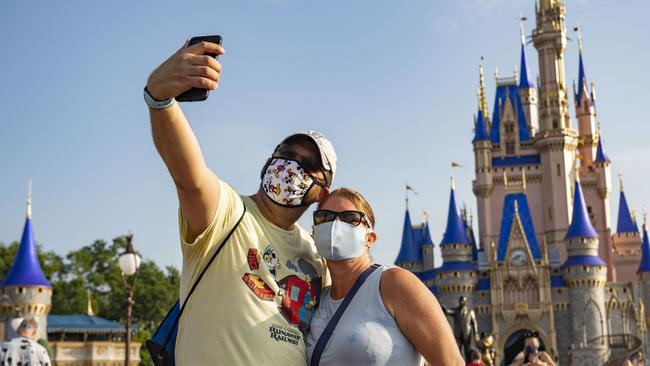Trump vs. coronavirus: Has America given up the fight?
The infection and death rates are staggering, but it is as if the US has all but surrendered the fight against COVID-19, which is being spread by a perfect storm of psychology.

Mickey Mouse welcomed thousands of masked tourists back to the theme park, while social media was littered with pictures of young Americans, without masks, partying cheek-to-cheek in homes and on beaches and boats farther south in Miami.
“Miami is now the epicentre of the pandemic,” infectious disease expert Lilian Abbo told a Miami press conference. “What we were seeing in Wuhan six months ago, five months ago, now we are there.”
The decision to allow the giant tourist magnet of Disney World to reopen as the pandemic roars out of control through Florida was just the latest whiplash moment in the way the sunbelt states in the US south and west are dealing with the sharp spike in COVID-19 infections.
New cases are rising in more than 40 of the 50 US states but they are surging at record levels in Florida, Texas and Arizona, where there is little serious attempt to curb the outbreak.
It is as if much of America has all but surrendered the fight against the pandemic, which has already killed more than 135,000 people and will continue to kill many more. This surrender starts at the top with Donald Trump abdicating leadership on the crisis by refusing to sanction a national testing regime, marshal any coherent federal response to the disaster or even tell the truth about it.
But America’s historic failure on the coronavirus goes deeper than Trump. State governors and city mayors, both Democrat and Republican, also have grievously misread the nature of the health threat and their response.
Yet there is more at play here. Many Americans, both those who need to keep working at on-site jobs to pay the bills and younger ones whose health is less at risk, increasingly view the virus as an inevitable part of life and are refusing to support further restrictions.

Rather than react as Victoria did by going into immediate lockdown, the Republican states of Florida, Texas and Arizona have tried to forge ahead with their reopenings, even as cases spike sharply.
The Republican governors of these states, with the strong encouragement of Trump, chose to start reopening their economies as early as May, arguing that the economic pain of remaining shuttered was greater than the health risks.
They pointed out at the time that their states had been affected only modestly by the virus as the early months of the pandemic cut a deadly swathe through the Democrat states in the northeast such as New York, New Jersey and Massachusetts, rather than the red states of the south and west.
But now the virus — aided by the early opening of bars, restaurants, gyms and beaches — is raging through the Republican sunbelt, hitting states such as Florida, Texas, Arizona, Georgia and the Carolinas that Trump must win to be re-elected in November. Governors including Florida’s Ron DeSantis are on the defensive as pressure mounts to reimpose restrictions.
The country’s top infectious disease expert, Anthony Fauci, says these states have only themselves to blame because they went from shutdowns to completely “throwing caution to the wind”.

So what factors are triggering this sudden spike across the Republican heartland and what does it mean for Trump’s chances of re-election?
In Florida and elsewhere in the sunbelt, the virus is being spread by a perfect storm of psychology, financial desperation and political and libertarian ideology.
When asked what has gone so wrong in Florida, Miami mayor Carlos Gimenez says many young Americans are simply sick of being cooped up and are giving up on social distancing to enjoy the summer months. “I think that (the spike) had a lot to do with probably socialising, young kids going to parties, maybe graduation parties at homes,” he says.
Across Florida, scenes of crowded bars, pools and beaches with few people wearing masks have been accompanied by a severe spike in cases with more than 77,000 of the states’ 300,000-plus cases recorded in the past week alone.
“I’m one of the people who contributed to the (figures),” says Ian Scott, a 19-year-old college student in Orlando who has tested positive. Scott says about half of his college fraternity had tested positive and that there is little downside for young people to catch it.
“We’re seeing positive, positive, positive, positive,” he told The New York Times. “My generation says: ‘Let’s get this over with. Let’s suck it up for two weeks, sit in our rooms, play video games, play with our phones, finish online classes, and it’s over.’ ”
In Florida, the average age of those infected has plunged from 65 in March to 39 now.
Also fuelling the spread in these states is the financial need for many low-wage workers, often minorities, to keep working, and for small business owners to try to stay open despite the growing health risks.
Most Republican voters in these states are also more inclined to oppose restrictions on their freedoms than their counterparts in Democrat states. Polls show Republicans, like their President, are less willing than Democrats to put on masks and more likely to prioritise the economy over fighting the virus.
But this libertarian ethos is being challenged by the sheer size of the outbreaks and the accompanying rise in hospitalisations and deaths. Even Trump wore a mask in public for the first time this week.
City mayors and state governors are being forced to pause or even rewind their push to reopen their economies despite opposition from the President. The spike in cases in states that Trump won narrowly at the 2016 election has made the pandemic far more dangerous for te President than it was early on, when the coronavirus primarily hit Democrat states such as New York.
In Florida — a must-win state that Trump took narrowly in 2016 and that has voted for the ultimate winner in 13 of the past 14 elections — he now trails his Democrat rival Joe Biden by six points, according to the bellwether RealClear Politics average of polls.
It will be a formidable challenge for Trump to turn around his fortunes in Florida given the surge in virus cases, which will not only unnerve the state’s many older voters but also will threaten the state’s economic recovery and jobs.
While young Floridians continue to party hard in the face of the virus, people aged 65 or older made up 21 per cent of the vote in Florida in 2016 and will be a key demographic in November.

In 2016 Trump easily won the over-65 vote nationally by seven percentage points, while no Democrat has won the seniors vote in two decades.
Yet a recent Siena College poll in six battleground states, including Florida, shows Biden leading Trump by six percentage points among over-65s, with seniors disapproving of the President’s handling of the pandemic by 52 per cent to 45 per cent.
A Change Research Poll this week found only 40 per cent of all Florida voters approve of Trump’s handling of the COVID-19 crisis, a figure that is likely to fall further as infections and deaths continue to rise.
Trump is also struggling in the virus hotspots of Texas and Arizona, Republican bastions that have not voted for a Democrat president since 1976 and 1996 respectively.
The RCP poll has Biden leading Trump by 2.8 points in Arizona and level in Texas.
Yet a new Dallas Morning News poll this week found Biden has edged to a 46-41 per cent lead over Trump in Texas amid concerns about the steep rise in coronavirus cases.
“While President Trump has and still enjoys near universal approval from (Texas) Republicans, and overwhelming disfavour from Democrats, he has lost considerable ground among the folks in the middle, who may ultimately decide who wins Texas in November,” says Kenneth Bryant, a political scientist at the University of Texas.
Perhaps more concerning for the President was a new CBS poll this week that found voters in Florida, Arizona and Texas were more inclined to blame him for the recent spikes than state governors and city mayors. The CBS poll found two-third of voters in these states say their state reopened too early because of political pressure from the President.
Nationally Biden still leads Trump by 49 per cent to 40.2 per cent, according to the RCP poll, with betting odds now pointing to a Biden victory by the heavy margin of 58.7 to 37.7.
These polls have encouraged Democrat strategists to dream not only of winning the White House but of retaking the Senate and expanding their majority in the lower house, allowing Biden, as president, to enact his agenda and rewind the Trump legacy.
The Biden team is expanding its focus beyond the key swing states of the midwest and has launched advertising campaigns in the once-staunchly pro-Trump states of Texas, Arizona, North Carolina and even Ohio, the bellwether state that has voted for the party of the presidential winner back to 1964.
Trump is also struggling against Biden in those three key midwest states of Michigan, Pennsylvania and Wisconsin, which delivered him the 2016 election but have since been hit hard by the virus.
In Michigan, which has lost more than 6300 people to COVID-19, the seventh highest of any state, Biden leads Trump by a solid 7.5 points. In Pennsylvania, which has suffered more than 6900 deaths, Biden has a 6.5 point lead, the same as in Wisconsin, although that state has only just over 800 deaths.

Faced with a fresh surge in the virus and falling approval ratings across the board, Trump has redoubled his push to encourage state governors to reopen their economies regardless of the prevalence of the virus. This is a pitch to the President’s hardline voter base of around 35 per cent, most of whom see the economic slowdown as a greater threat than the virus. But it still flies in the face of polls showing most Americans want to prioritise the fight against the virus over attempts to revive the economy. Trump knows that even a partial economic revival before November is his best chance of victory.
Trump is also pushing hard for US schools to reopen for physical classes in the new school year at the end of August but faces growing reluctance by schools to do so.
With virus case numbers surging in California, the school districts of Los Angeles and San Diego, two of the country’s largest, said this week that classes would be fully online, a decision the President labelled as a “mistake”.
“Schools should be opened, there’s kids who want to go to school, you’re losing a lot of lives by keeping things closed,” Trump says.
Schools are an important election issue for Trump. The ongoing physical closure of schools not only underlines the failure of the fight against the virus but also means many parents cannot return to their jobs because they are needed to look after their children at home.
Trump has framed the virus vs economy debate in political terms, accusing Democrat mayors and governors as well as the media and health experts of seeking to hold back the economy to harm his re-election chances.
He retweeted a message this week from conservative commentator Chuck Woolery, who accused all of these groups of “lying” about the situation.
“Everyone is lying,” Woolery tweeted. “The CDC, Media, Democrats, our Doctors, not all but most, that we are told to trust. I think it’s all about the election and keeping the economy from coming back, which is about the election. I’m sick of it.”
Trump now tries to avoid discussing the pandemic, but when he does he points out that death rates, although spiking up again towards 1000 a day, are still much lower than their peak of around 2500 in April.
Experts say this may be due to more young people catching the virus and better treatment plans, but they also warn that deaths are bound to rise further in the weeks ahead because of the soaring infection rates.
The testing regime in the US, however, is still piecemeal and dysfunctional. People are waiting many hours to get tested and up to a week to get results.
Even former Trump chief of staff Mick Mulvaney complained about it this week. “I know this isn’t popular to talk about in some Republican circles, but we still have a testing problem in this country,” Mulvaney wrote in an opinion piece. “My son was tested recently; we had to wait five to seven days for results … that is simply inexcusable at this point in the pandemic.”
The key question is how much will voters ultimately blame Trump for America’s failed response to the coronavirus pandemic, given that governors, mayors, a poorly co-ordinated federal system and the libertarian attitude of many Americans have also played their parts?
The President maintains the polls are wrong, just as they were in 2016 when most failed to predict his victory.
“I think we’re doing very well in the polls and I think you have a silent majority the likes of which this country has never seen before,” he says.
When the pandemic in the US began in March it hit the populous Democrat states and cities hardest, and therefore posed less of a political risk to the President.
Trump played politics with this situation and was vocal about the early spread being the result of failures by Democrat governors and mayors.

But now the virus is raging in Trump’s Republican backyard, spreading like a bushfire across his own red states.
Florida’s Governor DeSantis, who once boasted about his state’s early response to the virus and who chided his Democrat counterpart in New York, Andrew Cuomo, over the problems in that state, now has a similar fight on his hands.
“You played politics with this virus and you lost,” Cuomo now says of DeSantis.
As Republican states feel the wrath of COVID-19, the politics of the pandemic are also increasingly turning against Trump.
Unless he can turn it around fast, he is increasingly likely to be a one-term president.
Cameron Stewart is also US contributor for Sky News Australia.




This week in Florida, where new daily coronavirus cases surged to levels not before seen in the US — indeed in the world — Disney World reopened in Orlando in the state’s north.